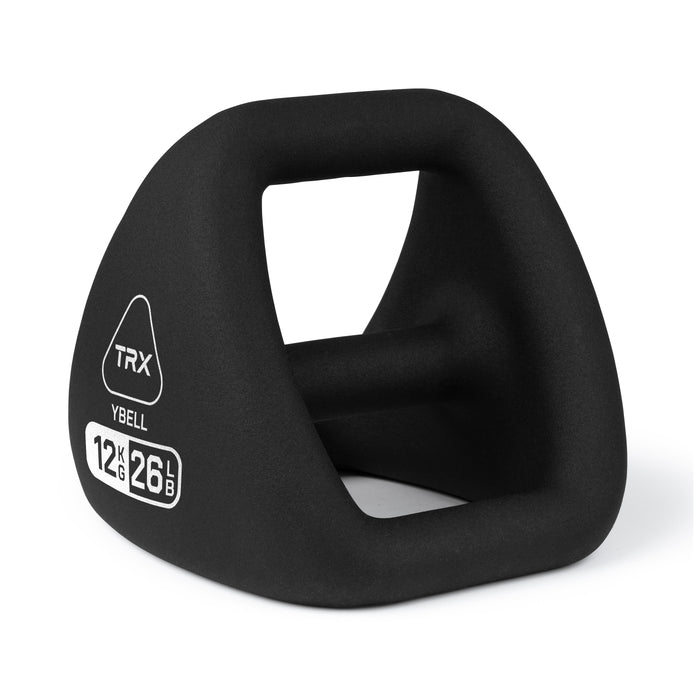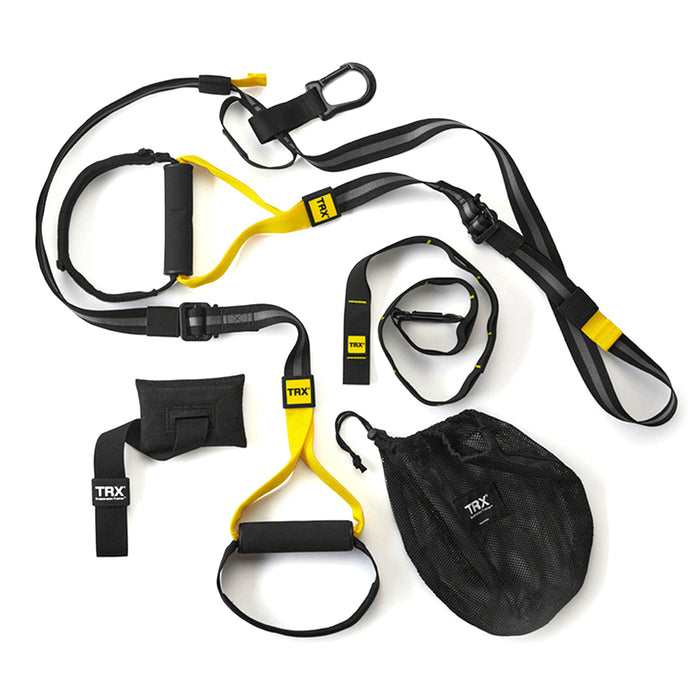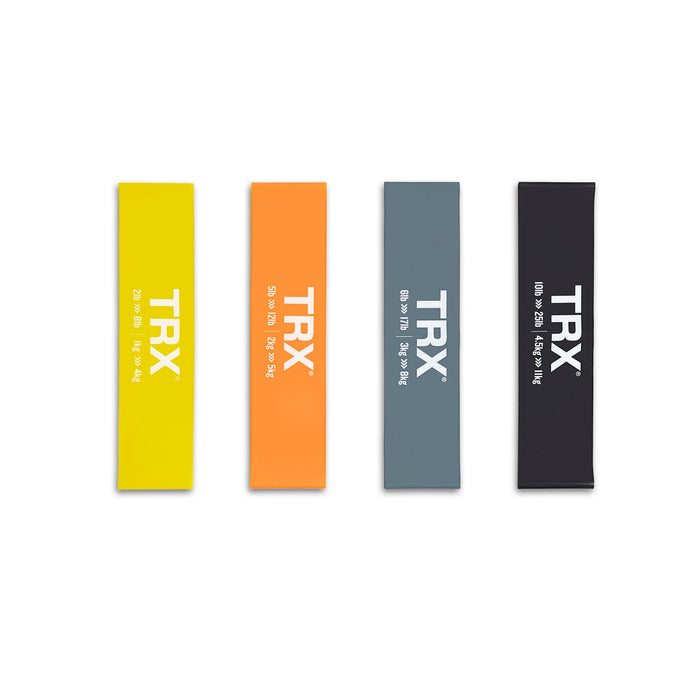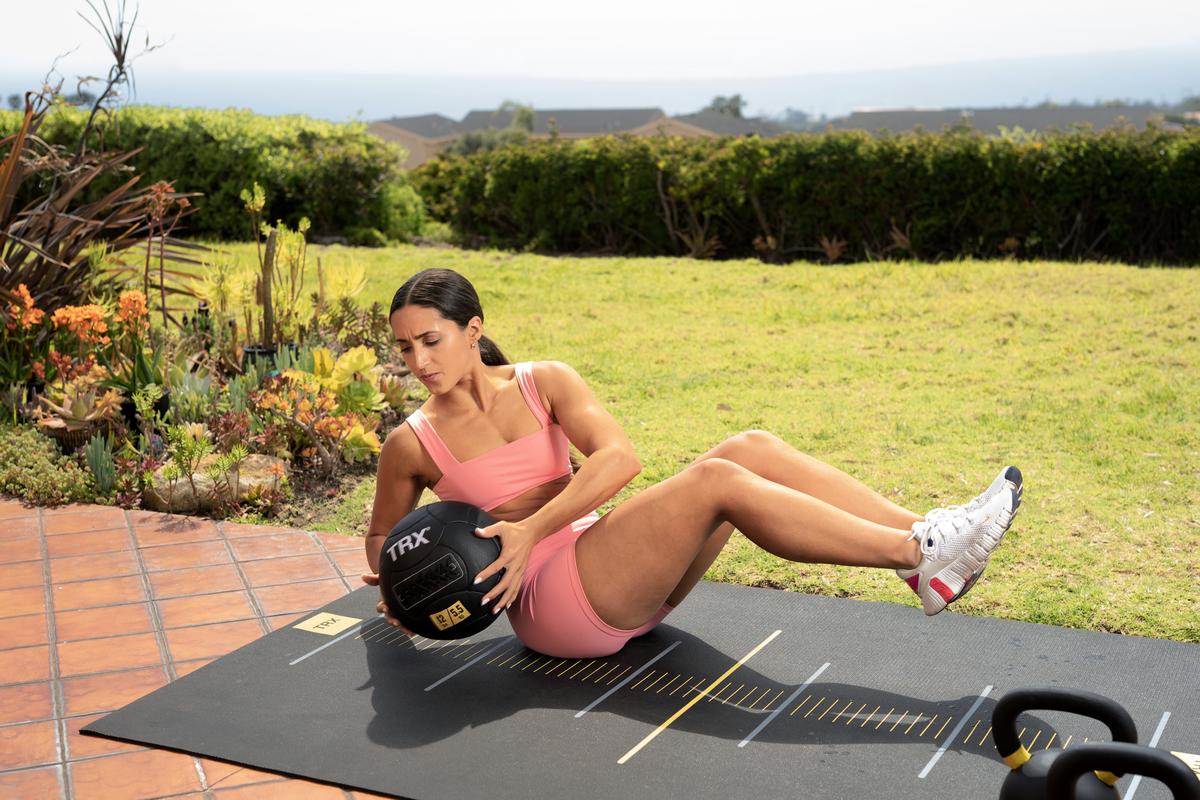You're not alone if you're considering setting up a home gym but unsure about the costs involved. Many people wonder about the expenses associated with this endeavor. However, building a home gym doesn't have to break the bank; it can be quite affordable and a wise financial choice.
In today's article, we'll explore home gym costs, benefits, and essential equipment including TRX gear. Want a personalized home gym setup recommendation? Take our quick assessment quiz to get equipment suggestions tailored to your space, budget and fitness goals. Let's get started!
TAKE OUR TRAINING QUIZ
Why Build A Home Gym
Going to the gym regularly can be quite a chore. From the effort of commuting to dealing with crowded spaces and waiting for equipment, there are several hurdles to overcome. Additionally, there's no guarantee that you'll always have access to the equipment you need due to gym limitations or other users hogging machines.
However, if feasible in terms of space and budget, investing in a home gym can eliminate these challenges. It offers greater flexibility and freedom in your workout schedule and equipment usage, allowing you to focus more on achieving your fitness objectives without the hassles of a public gym environment.
1. No Long Lines
Enjoying the hustle of the squat rack at the gym, waiting for a chance to squeeze in your set, can be thrilling. However, dealing with impatient looks from others can take away from the experience. With a home gym, you have the luxury of exclusivity—no waiting lines or pressure to rush through your workout.
2. No Need to Commute
One major drawback of opting for a commercial gym is the time and energy wasted in commuting. The hassle of driving through traffic, often back and forth, can be a significant deterrent for many individuals, leading them to skip workouts altogether. On the other hand, having a home gym in your garage or basement eliminates this commute, making it much more convenient to stay consistent with your exercise routine.
3. You Can Workout Anytime
A home gym offers the convenience of working out whenever and however frequently you prefer, without limitations based on holidays or weather conditions. You can get a full-body workout at home instead of driving thirty minutes out to your local gym. This accessibility has made twice-a-day workouts increasingly popular among fitness enthusiasts.
4. No Judgments
Not all peer influence is beneficial. Whether you're refining your technique or recuperating from an injury, the presence of others can sometimes lead to overexertion or pressure to keep up appearances by adding more weight. This can be a motivating factor for wanting a private space to focus on your fitness goals without external distractions or expectations.
5. Absence of Harassment
Having a home gym offers not just privacy but also safety, particularly for women. Some women have faced harassment at public gyms, highlighting the importance of a secure and comfortable workout environment. Access to safe facilities like lockers and restrooms can sometimes be challenging in public settings, making a home gym attractive for many individuals seeking a harassment-free workout space.
6. No Daycare
Balancing parental responsibilities with fitness goals can be challenging. However, having a personal space like a home gym can make it easier. Consider setting up a small playpen within your workout area to keep an eye on younger children while you exercise. Additionally, involve older children in physical activities to encourage family fitness and bonding. This approach allows you to be present for your family while also prioritizing your training routine.
7. Reduce the Chance of Getting an Infection
Commercial gyms can often suffer from issues like inadequate ventilation, which can contribute to the spread of bacteria and other health hazards. Moreover, the high traffic in gyms increases the risk of exposure to germs and infections. While a home gym may not be entirely germ-free, you have control over its cleanliness, such as knowing when the equipment was last sanitized. Working out alone in your home gym can significantly reduce your exposure to viral diseases and minimize contact with potentially harmful pathogens.
8. No Limitation
Owning a home gym comes with the perk of setting your own rules. If you don't feel like cleaning up or organizing today, you can always do it later. You can invite friends over without worrying about guest passes, play your favorite music as loud as you want, and customize the layout to suit your preferences. Plus, there are no recurring gym membership fees to deal with, adding to the convenience and freedom of having your own workout space.
Cost of Home Gym vs. Gym Membership
For many individuals contemplating home gym ownership, the primary factor influencing their decision is the cost difference between working out at a gym versus at home. While there are numerous advantages to having a home gym, the bottom line often boils down to financial considerations. Owning a home gym can not only offer convenience and customization but also prove to be a smart financial investment in the long run.
The typical expenditure for setting up a home gym falls within the range of $1,000 to $20,000. While this amount can vary widely based on individual preferences and equipment choices, it reflects what many people invest in their home fitness setups initially. Comparing these costs to a gym membership, which typically averages around $45 per month, highlights the potential financial advantages of a home gym. Unlike a membership fee that recurs monthly, a home gym represents an asset that can be leveraged for other purposes or even resold at a good value if chosen wisely. The ongoing expenses primarily revolve around maintaining the space, such as electricity for your garage or spare room.
Considering these financial aspects alone, opting for a home gym appears to be a more favorable decision compared to a gym membership in the long run.
What You Need To Build A Home Gym
Now that you are thinking about setting up a home gym, let's talk about the equipment you'll need. Keep in mind that everyone has unique fitness goals, so your gear should match what you want to achieve. However, there are some exercises that almost everyone can benefit from. Luckily, the equipment for these exercises is easy to find and doesn't cost a fortune.
Here are some recommended starting equipment options for most individuals:
- TRX® Home System
- TRX Suspension Trainer Pro4
- YBELL® Neo Series
- TRX Bandit®
- TRX RIP Trainer™
- TRX Slam Ball
- TRX Strength Bands
- TRX Rubber Coated Kettlebells
1. TRX Home System
Experience a full-body workout revolution with the Home2 System, an all-in-one tool that utilizes your body weight for strength, cardio, or mobility training wherever you go. Its soft and durable foam handles ensure a secure grip during any exercise, even when your hands sweat. Designed as your ultimate travel companion, this compact and portable system ensures you never miss a beat in your fitness routine, even when you're on the move.
2. TRX Suspension Trainer Pro4
The Pro 4 is a full-body system for intensive strength, cardio, and mobility workouts anywhere, backed by research, proven by athletes, and authorized by you. Its unique rubber handles prevent perspiration and friction, making it durable for demanding workouts. You may effortlessly modify the Velcro foot cradles for upper body, lower body, and core activities. The Pro 4 System has everything needed, no tools needed. Choose a door, tree, or pole and start working out.
3. YBELL Neo Series
The YBELL® NEO Series is a highly adaptable fitness tool crafted for strength training and comprehensive full-body workouts. Available in various weights, this TRX Ybell caters to individuals of all fitness levels and aspirations.
4. TRX Bandit
The TRX BANDIT® stands out as a groundbreaking fitness tool tailored for resistance training and bolstering strength, whether at the gym or at home. Its universal fit grip not only boosts strength but also minimizes discomfort often caused by traditional resistance bands, thanks to its design that eliminates pinching and irritation. With its slip-free rubber grip, safety is prioritized, allowing for a smooth and effective range of resistance exercises.
5. TRX RIP Trainer
The TRX Rip Trainer is popular for athletes and fitness enthusiasts seeking rotational strength. It improves speed and control in golf, lacrosse, baseball, and racquet sports. Durability is built into the Rip Trainer's steel core and rubber handles. Ergonomic design and non-slip grip allow multidirectional movements for full-body challenges. The tiny, lightweight Rip Trainer fits in a backpack or carry-on for on-the-go exercises and is easy to set up.
6. TRX Slam Ball
The TRX Rip Trainer is popular for athletes and fitness enthusiasts seeking rotational strength. It improves speed and control in golf, lacrosse, baseball, and racquet sports. Durability is built into the Rip Trainer's steel core and rubber handles. Ergonomic design and non-slip grip allow multidirectional movements for full-body challenges. The tiny, lightweight Rip Trainer fits in a backpack or carry-on for on-the-go exercises and is easy to set up.
7. TRX Strength Bands
TRX Strength Bands offers a complete elastic band solution for full-body workouts anywhere you go. These flexible bands are perfect for increasing resistance without causing impact, making them a versatile tool for various exercises. By increasing time under tension, they optimize effort and results in each movement, enhancing strength, endurance, and power. Additionally, they are excellent for post-workout stretching or rehabilitation purposes, adding to their functionality and value in a fitness routine.
8. TRX Rubber Coated Kettlebells
The TRX Rubber Coated Kettlebells are crafted with high-quality materials, including a durable rubber coating on the bell, a powder-coated handle, and a machined flat base, ensuring robust and functional durability. The smooth finish of these kettlebells helps prevent scuffs and chips on the bell while also offering protection for your flooring. With a textured cast iron handle, they provide a comfortable and flexible grip for a wide range of exercises such as swings, presses, squats, snatches, and more.
You might also consider an all-in-one home gym machine, which can fulfill multiple workout needs. Additionally, there are several other tools you can incorporate into your setup gradually, such as adjustable dumbbells, kettlebells, a treadmill, and a lat pulldown machine.
These additions can be made as your fitness goals evolve and your preferences develop. It's generally advisable to avoid purchasing everything at once unless you're aiming to save on shipping costs. However, if you're new to home workouts and unsure about your preferences or workout habits, buying everything at once can be counterproductive.
Try one of our TRX products today:
How to Build a Home Gym Without Spending Too Much?
Premium fitness equipment can come with a hefty price tag. If you have the means, by all means, invest in top-of-the-line products for your dream home gym. We'd love to see your state-of-the-art setup in your spacious 3-car garage whenever it's ready! However, for those aiming to build a modest yet effective fitness space without breaking the bank, here are some valuable tips to consider.
1. Buy Second Hand Equipment
Secondhand equipment might help you save money on home gym equipment. Home gyms, from extravagant to simple, increased throughout the pandemic. Many people are selling high-quality gym gear at low costs as public venues and fitness centers reopen. This is a great chance to buy high-quality equipment at a fraction of their original cost, decreasing your home gym construction costs. Record your electronics' serial number and contact the manufacturer for parts availability and service history.
2. DIY Equipment
If buying old, well-worn goods doesn't appeal to you, there are ways to optimize new product value. First, watch for bargains and special deals on specific things to save money. Second, many retailers provide free delivery for orders above a certain amount, so consider consolidating your purchases. Consider zero-interest financing, which lets you pay for your items over time without interest. These methods can maximize your fitness equipment purchase.
3. Utilize Multi-Purpose Equipment
Choose multipurpose equipment to save money and space in your home gym. Instead of chest fly or leg press machines, consider a cable machine, which targets legs, arms, back, and chest but costs more. If money is tight, consider suspension trainers like TRX or pulley systems. Landmines, sometimes known as core plates, can improve barbell exercises by adding drill alternatives and angles. Medicine balls, kettlebells, and resistance bands are versatile and effective without weight room equipment for a well-rounded home gym.
Things Affecting Home Gym Cost
Understanding the factors that affect home gym costs is essential for making informed decisions and setting a realistic budget. These criteria can include equipment kind and quality, room size, additional features or accessories, installation and setup costs, continuing maintenance costs, and future upgrades or expansions. Luckily, there’s plenty of budget-friendly home gym equipment that you can buy. By carefully examining these components, you can build a home gym that suits your demands and fits your budget.
1. Choice of Equipment
Gym equipment prices vary by category. Yoga mats, jump ropes, medicine balls, and resistance bands are cheap. After free weights, there are squat racks, exercise stations, and cardio machines.
Many companies charge extra for the skilled assembly of larger and more complex equipment. Equipment quality and brand reputation also affect cost. Most manufacturers provide home gym equipment that performs like commercial equipment at competitive prices.
Since home gyms serve fewer people, commercial-grade build quality isn't usually necessary. You may miss advanced tech and networking features in commercial gym gear. For long-term use and peace of mind, buy robust equipment with a warranty.
2. Type of Training
Your gym's primary purpose greatly influences the equipment choices and costs involved. Whether you're focused on yoga, cardio, weightlifting, or addressing age-related health concerns as per medical advice, your gym setup will vary significantly.
For yoga or pilates, the essential equipment list is relatively short. However, strength training demands a broader range of tools, including a barbell, a weight plate set, and a sturdy bench, even at a basic level.
Investing in high-quality cardio machines like treadmills, stationary bikes, or rowers can be costly and require ample space. Nonetheless, these machines typically offer excellent durability and retain good resale value over time.
3. Gym Location
A foldable treadmill can fit under your bed, but a home gym needs space. For this, transform your garage, cellar, attic, or a large extra space. You can even exercise in your backyard or terrace if the weather is nice. You might also utilize living room dividers or build a separate structure.
Your training room selection and preparation can greatly affect the cost of your home gym setup. Layout, ventilation, lighting, and floor reinforcement are essential for a functional and comfortable workout.
4. Floor Plan
Flooring is important in a strength-focused gym with hefty machines. The proper flooring supports heavy equipment, disperses energy, and maintains stability, reducing slips and falls. Choose from many flooring selections.
Homeowners like rubber tiles and rolls because they are durable and affordable. Depending on your budget and interests, consider foam, vinyl, hardwood, and carpets. A subfloor inspection is necessary before installing new flooring. The sturdy subfloor underlying your gym flooring may need repairs or replacement to support and last.
So, Should You Build Your Home Gym?
We say yes. A home gym may cost anywhere between $1,000 to $20,000, but the benefits are immeasureable. You get access to your own private space and you pay less in the long-term if you can keep your equipment in good shape.
At TRX, we’re committed to improving your well-being through fitness and we strongly believe that home gym is one of the most effective ways to do so.






